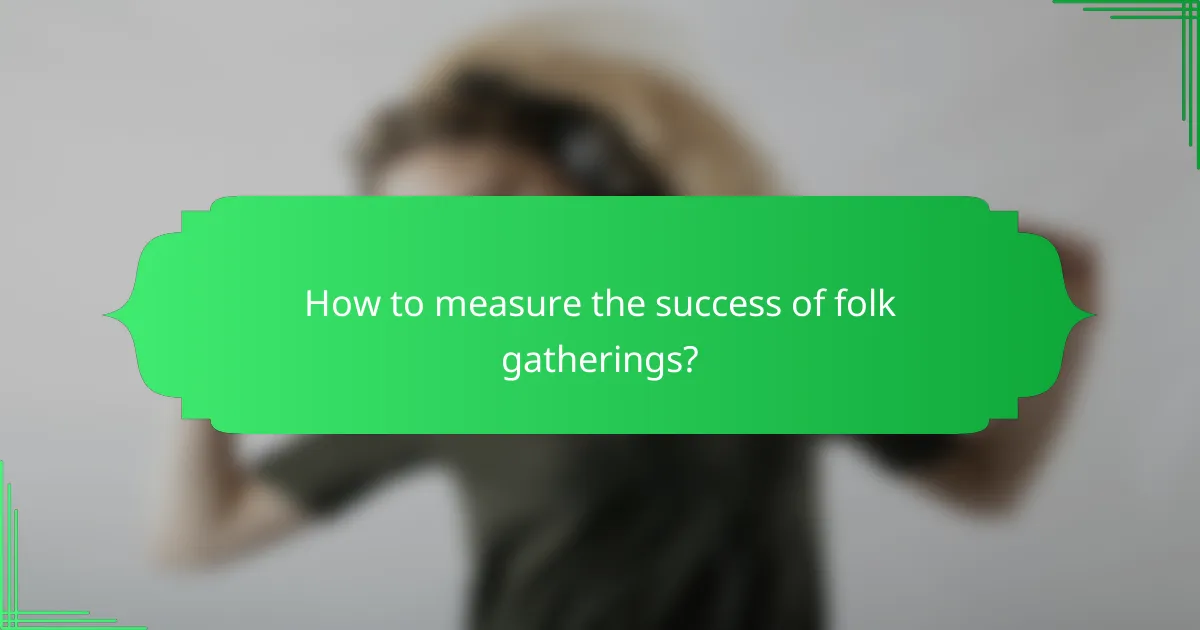Folk gatherings in Canada provide a vibrant platform for storytelling sessions, acoustic performances, and cultural sharing, creating a welcoming environment for all. By focusing on the interests of the local community, these events foster engagement and participation, allowing diverse narratives and musical expressions to flourish. Through intimate settings, attendees can connect deeply with both the stories and the music, enriching their cultural appreciation.

How to organize folk gatherings in Canada?
To organize folk gatherings in Canada, focus on creating a welcoming environment that fosters storytelling, acoustic performances, and cultural sharing. Consider the local community’s interests and preferences to ensure participation and engagement.
Venue selection for storytelling sessions
Selecting the right venue for storytelling sessions is crucial. Look for spaces that are intimate and acoustically friendly, such as community centers, libraries, or local cafes. Ensure the venue can accommodate the expected audience size, typically ranging from a small group to a few dozen attendees.
Consider accessibility and comfort, including seating arrangements and facilities for those with disabilities. Outdoor venues can also be appealing, especially in warmer months, but ensure you have a backup plan for inclement weather.
Permits and regulations for acoustic performances
Acoustic performances may require specific permits depending on the location and nature of the event. Check with local municipalities to understand noise regulations and public performance permits, which can vary widely across provinces and cities.
In many cases, small gatherings in private venues may not require permits, while larger public events might need to adhere to stricter guidelines. Always confirm the requirements well in advance to avoid last-minute complications.
Community engagement strategies
Engaging the community is essential for the success of folk gatherings. Utilize social media platforms, local bulletin boards, and community newsletters to promote the event and attract participants. Collaborating with local artists and cultural organizations can also enhance visibility and credibility.
Consider hosting pre-event workshops or open mic nights to build excitement and encourage community involvement. Offering incentives, such as free refreshments or small prizes for participation, can further motivate attendance and engagement.

What types of storytelling sessions are popular?
Popular storytelling sessions include various formats that engage audiences through cultural narratives, personal experiences, and traditional tales. These sessions often vary in style and content, catering to diverse interests and backgrounds.
Indigenous storytelling traditions
Indigenous storytelling traditions are rich with history and cultural significance, often passed down through generations. These sessions typically feature oral narratives that convey moral lessons, historical events, and spiritual beliefs unique to each community.
Participants can expect to hear stories that reflect the values and teachings of Indigenous cultures, often accompanied by traditional music or dance. Engaging with these stories fosters a deeper understanding of the cultural heritage and perspectives of Indigenous peoples.
Personal narrative sharing
Personal narrative sharing focuses on individual experiences and life stories, allowing participants to connect on a personal level. These sessions encourage storytellers to express their emotions, challenges, and triumphs, creating an intimate atmosphere.
Listeners often find resonance in these narratives, as they reflect universal themes of love, loss, and resilience. To enhance engagement, storytellers may use prompts or themes to guide their narratives, making the sessions relatable and impactful.
Folklore and myth retellings
Folklore and myth retellings bring to life the timeless tales that shape cultural identities. These sessions often feature well-known stories that have been adapted over time, highlighting the moral lessons and cultural values embedded within them.
Storytellers may incorporate various techniques, such as dramatic readings or interactive elements, to captivate their audience. By exploring these narratives, participants gain insight into the cultural contexts from which they originate, enriching their understanding of different societies.

What are the benefits of acoustic performances?
Acoustic performances offer numerous benefits, including fostering community engagement and enhancing cultural appreciation. These events create intimate settings where audiences can connect deeply with the music and each other.
Enhancing community connections
Acoustic performances serve as a platform for individuals to come together, fostering a sense of belonging and community. By participating in these gatherings, attendees can share experiences and stories, strengthening interpersonal bonds.
Local venues often host regular acoustic nights, encouraging residents to interact and collaborate. This can lead to the formation of new friendships and networks, enriching the social fabric of the area.
Supporting local artists
Acoustic performances provide vital exposure for local musicians, allowing them to showcase their talent to a receptive audience. This support is crucial for artists who may not have access to larger venues or commercial opportunities.
By attending these events, community members contribute to the local economy, often paying a small cover charge or purchasing merchandise. This financial backing helps sustain artists and encourages them to continue creating music.
Creating immersive cultural experiences
Acoustic performances often highlight traditional music and storytelling, offering audiences a glimpse into the cultural heritage of a community. These events can include folk tales, regional songs, and unique instruments that reflect local history.
Engaging with these cultural experiences can deepen appreciation for diversity and promote understanding among different groups. Attendees may leave with a greater sense of connection to their roots and the broader cultural landscape.

How to promote cultural sharing at gatherings?
Promoting cultural sharing at gatherings involves creating an inclusive environment where diverse traditions and stories can be shared openly. This can be achieved through effective communication, collaboration, and engaging activities that highlight various cultural expressions.
Utilizing social media platforms
Social media is a powerful tool for promoting cultural sharing at gatherings. Platforms like Facebook, Instagram, and Twitter allow organizers to reach a wider audience, share event details, and showcase cultural highlights. Regular updates and engaging content can build anticipation and encourage participation.
Consider creating event-specific hashtags to facilitate discussions and sharing among attendees. This not only promotes the gathering but also allows participants to share their experiences and cultural insights with a broader community.
Collaborating with local cultural organizations
Partnering with local cultural organizations can enhance the authenticity and richness of your gathering. These organizations often have established networks and resources that can help promote the event and attract a diverse audience. They may also provide speakers, performers, or workshops that enrich the cultural experience.
Reach out to community centers, cultural associations, or local artists to explore collaboration opportunities. This can lead to mutually beneficial partnerships that foster cultural exchange and strengthen community ties.
Creating engaging promotional materials
Effective promotional materials are essential for attracting attendees and conveying the essence of cultural sharing. Use eye-catching designs and clear messaging that reflect the diversity of cultures represented at the gathering. Flyers, posters, and digital graphics can all serve this purpose.
Incorporate visuals and stories that highlight the unique aspects of the cultures involved. Consider using QR codes that link to videos or testimonials from past events, providing potential attendees with a glimpse of what to expect and encouraging them to participate.

What are the key criteria for selecting performers?
Choosing performers for folk gatherings involves evaluating their experience, cultural relevance, and ability to engage the audience. These criteria ensure that the event resonates with attendees and maintains the integrity of the cultural themes being presented.
Experience and skill level
Performers should have a solid background in their craft, whether it be storytelling, music, or cultural demonstrations. Look for individuals with several years of experience or those who have performed at similar events, as this often indicates reliability and professionalism.
Skill level can be assessed through previous performances, recordings, or testimonials from past organizers. A mix of seasoned artists and emerging talents can create a dynamic atmosphere, appealing to a broader audience.
Relevance to cultural themes
It’s crucial that performers align with the cultural themes of the gathering. This relevance can be established through their repertoire, storytelling style, or the cultural background they represent. For instance, if the event focuses on Appalachian traditions, performers should have a strong connection to that heritage.
Consider how well the performers can convey the stories and values of the culture in question. Engaging artists who understand the nuances of the culture can foster a deeper connection with the audience and enhance the overall experience.
Audience engagement potential
Performers should be capable of captivating the audience and encouraging participation. Look for individuals who have a track record of interactive performances, such as inviting audience members to share their own stories or participate in sing-alongs.
Assessing their charisma and stage presence can be done through video samples or live auditions. Engaging performers can significantly enhance the atmosphere of the gathering, making it memorable for all attendees.

How to measure the success of folk gatherings?
Measuring the success of folk gatherings involves evaluating participant engagement, feedback, and the overall atmosphere. Key indicators include attendance numbers, audience interaction, and the quality of cultural exchange during storytelling sessions and acoustic performances.
Attendance and Participation Rates
Attendance is a primary metric for assessing the success of folk gatherings. A higher turnout often indicates effective promotion and community interest. Tracking participation rates in various activities, such as storytelling sessions and performances, can provide insights into which elements resonate most with attendees.
Consider setting benchmarks based on previous events or similar gatherings in the area. For instance, a successful folk gathering might aim for at least 50-100 attendees, depending on the venue size and community engagement.
Audience Engagement
Audience engagement is crucial for determining the impact of folk gatherings. This can be measured through direct interaction, such as audience participation in storytelling or Q&A sessions, and through social media engagement before and after the event. Positive interactions often lead to a more vibrant atmosphere and encourage repeat attendance.
To enhance engagement, consider incorporating interactive elements like workshops or open mic sessions. These not only foster participation but also create a sense of community among attendees.
Feedback and Satisfaction
Collecting feedback from participants is essential for evaluating the success of folk gatherings. Surveys or informal discussions can provide insights into what attendees enjoyed and what could be improved. Look for feedback on aspects like the quality of performances, the relevance of stories shared, and the overall organization of the event.
Implementing a simple feedback form can help gather this information efficiently. Aim for a balance between quantitative ratings and qualitative comments to get a comprehensive view of attendee satisfaction.
Cultural Impact and Community Connection
The cultural impact of folk gatherings can be assessed through the depth of cultural sharing and the connections formed within the community. Successful events often lead to increased interest in local traditions and storytelling practices, fostering a sense of pride and identity among participants.
Consider organizing follow-up events or workshops that build on the themes presented during the gathering. This not only strengthens community ties but also encourages ongoing cultural exchange and learning.
